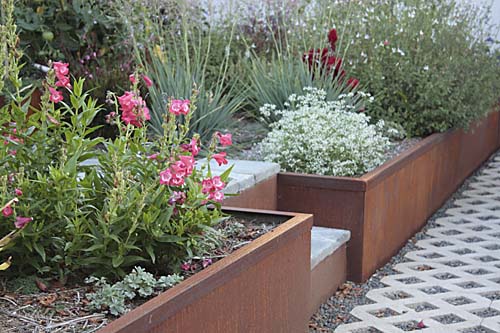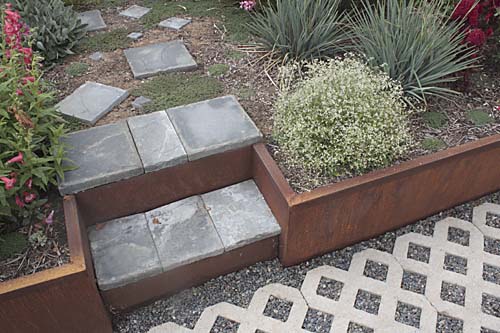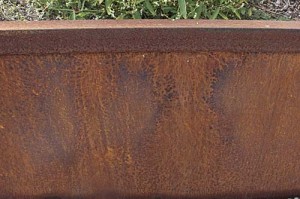Picasso and on occasion other artists have been credited with the quote that goes something like, “Good artists copy, great artists steal.”
Left: Garden at the Getty Center, Los Angeles [ source ]
The garden designed by Robert Irwin at the Getty Museum in Los Angeles has both received raves and been the topic of rants. After my visits there I’m torn somewhere in between. There are things I like about it, and there are things that seem like missed opportunities or inappropriate choices.
One of the things I really like is its use of sheets of steel for retaining walls. (You can see it in the foreground and middle-ground in this picture.)
Each material that you use in a garden–whether it be wood or stone or steel–has its own personality. I particularly like the warm brown color that that steel ages to, as well as the industrial vibe that it brings.
While it probably doesn’t rise to the Picasso’s level of theft, using sheet steel for retaining walls is an idea I’ve incorporated into my own garden. Two sides of the raised bed I put in last fall use the material.
My gardening budget is nothing like the Getty Museum’s, so instead of inch-thick material I used 11-gauge sheets (just shy of 1/8 inch thick). Also, since steel is heavy stuff, thinner sheets don’t require heavy equipment and can be handled by two people. I welded inch-and-a-half angle iron to the top edges, both to give it extra rigidity to help hold back the soil and to give my scrawny little sheets some visual heft.
Over eight months the walls have taken on a warm patina and are almost as alive as the plants in the bed.
I don’t consider myself to be mainly swayed by practicality over aesthetics. Since steel rusts and degrades over time, using it for a retaining wall is probably a less durable option than using other materials. Still, as far as the longevity of the steel is concerned, I’m encouraged by a scrap that I’ve had outdoors for the last ten years. When I cut into it recently the interior was pristine and shiny. Only the outer shell showed any signs of rust. Of course, steel that’s in constant contact with the ground and moisture–like my garden retaining wall–will degrade quite a bit faster.
We’ll see whether this is a five-year solution or one that will outlive me.





You are the King of garden hardscaping (and a welder, too!?!?!)! I just love the way your gardens look…not only the steel walls, but also the stonework in your paths (are those lattice stone blocks with gravel?) and the steps and well, everything…it all just looks so great!
Now, what can you tell about those “trees” at the Getty? I’ve never been and from your photo, I have the impression they are actually vines of some kind funneled up toward the sky. Interesting effect, for sure…but what’s the plant material?
Thanks, Greg. One of these day’s I’ll post the shots from the back 40–so much of this yard is still a work in progress and not nearly so finished looking!
The Getty trees are bent pieces of rebar steel, welded together with rings to hold them together. Growing inside the trees are bougainvillea vines. They’re soooo common in Southern California. But dang they are pretty spectacular for 8 months of the year!
This looks amazing! I’m thinking of doing something similar in my garden – where (what type of store/supplier) did you buy your steel? Thanks!
JP, there are a couple of metal suppliers in town. One that’s nearby, Industrial Metal Supply (IMS), is like a big candy store for me, and they cut their sheets to order, even for hobbyists and homeowners. Another of the metal suppliers in town will do the same. They charge for the service, but if your project is large enough, it’s not a huge part of the budget…
These are beautiful! Out of curiosity, how did you secure them into the ground? I’ve been looking into building something similar and a good solution for securing them has eluded me.
Jack, there are steel stakes welded to the back sides of the planters, maybe every 2-3 feet. The stakes go 18-24 inches into the ground. I didn’t treat the stakes with anything–either wrapping or painting or covering them with waterproofing–and that’s a weakness in what I did, something I’d do differently. Fortunately, with the dirt inside the planters, most of the stress is downward, not outward. Also, there are 90-degree parts integral to the structure that also help reinforce the sides. I hope that helps!
Thanks for the quick reply! Im leaning towards non corten steel since you mentioned its not recommended in this application. Ive also read good things of painting polyurethane clear coat even after rusting .
did you put the stakes in the ground first, make them straight then tac the sheet to the stakes?
Chad, yes. I put in the stakes and then tacked the steel sides to them. Thanks for the note about the polyurethane!
An awesome design. Thanks for sharing.
I’m looking to do something similar in my garden. How has this held up through the years? How tall are these walls? Did you use any drainage rock behind the wall? Other than treating the stakes for waterproofing, would you do anything different? Many thanks in advance if you’re able to reply to this message. I haven’t been able to find a lot of info on these types of DIY retaining walls and yours look great!
Apologies for the slow response, but this blog has been on hiatus for a while. A quick note on this project: It held up pretty well for about 8-10 years, and has started to fail in some areas, most notably at the lowest ground contact point and at the soil line, where much of the steel has rusted through. I would engineer it differently the next time. Drainage as you mention would help, I’m sure. I saw the detailing of the steel project going up at the LA County Museum of Art, where they appeared to coat all ground contact points with some sort of black barrier goo (how’s that for scientific?). I’ve also heard of people coating the ground contact areas with a fiberglass layer to isolate the steel from the soil. I’ve recently cut into steel pieces that were not in ground contact. Though corroded-looking on the surface, they were shiny and metallic inside and as sturdy as they were 15 years ago. So…this was an experiment. Not entirely successful, but it still is an efficient way to contain soil with something so thin. I intend to do some updates to some stories on this site, and this will be one of them.
Such a slick look, it’s a great-looking retaining wall and stairs. Thanks for sharing!